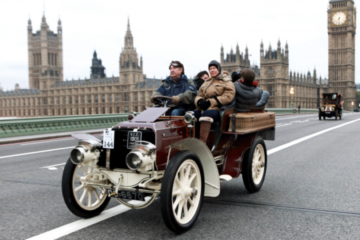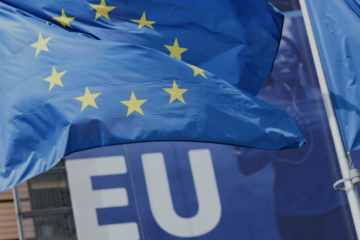Exactly a week after senior European Union officials arrived in Kyiv for the 24th EU-Ukraine Summit, President Volodymyr Zelensky set off on a charm offensive tour around Europe.
He started with a surprise trip to London on Wednesday, February 9th, addressing the UK parliament and urging allies to provide “wings for freedom” – fighter jets – for Ukraine. Zelensky later headed to Paris to meet French President Emmanuel Macron and German Chancellor Olaf Scholz before flying to Brussels and addressing the European Parliament. The President’s visits and repeated calls for increased military and financial support come at a time of intensified Russian offensives as the war enters its second year.
Despite these developments, little has changed since the summit, neither in terms of discourse, nor policy: Ukraine is still pushing for fast-tracked EU membership, but little action is actually being taken. In fact, the opposite might be true. The UK’s Secretary for Defence Ben Wallace has told reporters that no fighter jets are coming to Ukraine anytime soon. Scholz meanwhile has vowed that his country will not engage in a “bidding war” over support for Ukraine. Dutch Prime Minister Mark Rutte has warned the West against risking an “Article 5 direct confrontation” between Russia and NATO over the delivery of jets. All in all, European leaders have long been urging Brussels to rein in Ukraine’s “unrealistic” EU hopes.
What does this tell us about the future of EU-Ukraine relations in the context of ending the war, guaranteeing Ukraine’s territorial integrity and fostering closer regional cooperation? Europe is engaged in a delicate balancing act between rhetoric and reality – and it cannot afford to make a mistake. While it can be argued that the EU’s current approach fails to manage expectations and deliver results, the recent summit emerges as an important case study that sheds light on the logics of EU-Ukraine cooperation. An upbeat hopeful rhetoric about the country’s future in the bloc is necessary for building long-term support and boosting morale; realistic yet modest policy outcomes are guaranteed to increase Ukraine’s resilience while maintaining consensus among Member States.
24th EU-Ukraine Summit
On February 3rd, President Zelensky hosted European Commission President Ursula von der Leyen and European Council President Charles Michel in Kyiv in a highly anticipated meeting. It was the first summit since the start of the war and since Ukraine was granted candidate status. Air raid alerts blared across the country twice during the day – a powerful reminder of the day-to-day reality of war. Zelensky described the meeting as a “European integration day” and used the summit to step up calls for allies to deliver long-range weapons to help repel Russian forces besieging the city of Bakhmut and occupying much of the eastern Donbas region. At the press conference, Charles Michel was eager to underline two points: that the EU will support Ukraine and its people “in every way we can, for as long as it takes” and that the future of Ukraine is within the EU. Despite the hopeful rhetoric, the reality on the ground turned out to be very different.
Accession
While von der Leyen and Michel have been strongly advocating for Ukrainian accession into the EU, some European capitals are far more cautious about the prospect. Prior to the summit, they had been warning Brussels against encouraging Ukraine’s unrealistic expectations of rapidly joining the bloc by 2026 or even, according to Zelensky’s latest statement in the EU Parliament, by the end of this year. The bloc remains largely divided on the issue: some Central and Eastern European Member States, including Poland and the Baltic states, have been championing Ukraine’s demands, while Northern and Western states have been more sceptical about the integration of the country’s sizable poor population and vast agricultural sector into the EU. These states have drawn attention to the wide remaining gaps in rule of law and judiciary alignment, as well as in the fight against corruption. They also pointed out that references to “considerable progress” might be premature and “pre-empting the normal steps in the accession process”. Last year, President Macron said that it could be “decades” before Ukraine could join the bloc. To be clear, things have been visibly moving. When the EU granted candidate status to Ukraine in June 2022, its decision was based on the understanding that Kyiv would undertake a series of legislative and policy reforms. These include enacting legislation on a selection process for the country’s Constitutional Court judges on a competitive basis, strengthening the fight against corruption, harmonising media regulation with EU standards, and protecting national minorities. Zelensky’s Government has pushed forward with its crackdown on high-level corruption, with Transparency International recently praising Ukraine for its steady progress on this front. But Ukraine still ranks a low 116 out of 180 countries on their list. Going forward, it is not clear how the Government can keep up the reforms at an accelerated pace while actively fighting a war and with an economy drained by defence spending.
Senior EU leaders, however, have understood the importance of language and rhetoric in the context of this war from day one: the EU must, at least through words and public statements, show unwavering support for Ukraine every step of the way. For them, and for Zelensky, this is ultimately a war on values, on democracy, on the European “way of life”. Therefore, the message must be clear – for Europeans, Ukrainians, foreign audiences and Russia alike: Europe is united, prepared and capable of supporting Ukraine for as long as it takes. And the bloc’s leaders have delivered. Despite internal divisions between Member States, they took on the job of presenting a strong and united front through a powerful pro-Ukrainian rhetoric that has clashed, at times, with the reality of policy discussions. Michel’s closing statement at the summit perfectly articulates the EU’s mission statement: “We will be right by your side to rebuild a modern, prosperous Ukraine firmly anchored on our common European path. Because there can be no safe and independent Europe without a safe and independent Ukraine. Ukraine is the EU, the EU is Ukraine, let’s make it happen.”
In reality, the summit’s results on accession were modest at best. The EU acknowledged considerable efforts in recent months to meet the objectives and reaffirmed that the implementation of judicial reforms in line with the recommendations of the Venice commissions remains vital. It underwhelmingly stated that it will decide on further steps once Ukraine has fulfilled the conditions outlined in EU’s Opinion on membership and promised to report back both as part of its enlargement package in Autumn 2023 and outside of its regular reporting through an update in Spring 2023.
They have, however, explored other mechanisms for enhanced cooperation that are expected to ensure closer alignment to the EU, such as unlocking the full potential of the Association Agreement and its Deep and Comprehensive Free Trade Agreement. This is expected to enhance economic and trade relations leading towards Ukraine’s integration into the EU’s Internal Market. The proposed measures include extending the suspension of import duties on Ukrainian exports beyond June, joining the Single Market Programme and including Ukraine in the European roaming area. Ukraine and the European Commission have also concluded partnerships on scientific research, energy and the sustainable reconstruction of cities.
EU Response
Although the summit might not have satisfied Ukraine’s hopes for accession, it has delivered other important results. On the topic of accountability, the EU has condemned Russia’s illegal annexation of the occupied regions and the systematic use of missiles and drones to attack civilians and civilian infrastructure in breach of International Humanitarian Law. Falling short of Ukraine’s preference for establishing a Special Tribunal, the EU has announced its support for the development of an International Centre for the Prosecution of the Crime of Aggression in Ukraine (ICPA) in the Hague in order to “coordinate the investigation of war crimes, preserve and store evidence for future trials”. The EU also reiterated its readiness to support President Zelensky’s peace formula and work with Ukraine on the 10-point peace plan.
European states are increasing collective pressure on Russia through the EU’s ninth package of restrictive measures and their ban on Russian diesel fuel and oil products which aims to cut dependency on Moscow and reduce Kremlin’s fossil fuel earnings. The tenth package of sanctions is expected to be unveiled on February 24th, marking the anniversary of the full-scale invasion. According to von der Leyen, the sanctions will target the components found in drones to prevent Russia from accessing these resources. The EU is ramping up its military support through the European Peace Facility and the launch of the EU Military Assistance Mission, which will train an initial 30000 soldiers in 2023. The overall military support of EU Member States is estimated to be around €12 billion. So far, nearly €50 billion has been delivered in terms of overall financial assistance, with a new €1 billion for fast recovery to be made available soon. The EU has also been providing emergency energy support, including generators, LED light bulbs and financial assistance, following the targeted Russian strikes on critical infrastructure.
One of the main outcomes of the summit has been an enhanced focus on cooperation for reconstruction and relief. In addition to the continued provision of humanitarian and civil protection assistance, reconstruction of social infrastructure, harmonised rights for displaced persons and a new package to support the Humanitarian Mine Action, the EU has announced that it will accelerate its work towards the use of Russia’s frozen assets in financing Ukraine’s reconstruction. Finally, in light of the global crisis triggered by Russia’s weaponisation of food, the EU has proposed strengthening its Solidarity Lanes. Together with the UN Black Sea Grain Initiative and the Grain from Ukraine programme, the Solidarity Lanes help ensure continued availability and affordability of food and fertilisers, particularly in developing countries dependent on Ukrainian exports. The alternative overland routes enable Ukraine to export its agri-food production by providing transport infrastructure and connections, storage on EU territory, faster customs operations and barrier-free trade with global partners.
Back to the future
Ultimately, while officials repeatedly emphasised the symbolism of holding talks in Ukraine, it is clear that the policy details the two sides negotiated during the summit were pragmatic: mobile phone roaming charges, suspension of import duties, joint gas purchases and infrastructure rehabilitation. The result of the accession talks was as technocratic as one can expect from a European summit: “The EU will decide on further steps once Ukraine fulfils the conditions outlined in the European Commission’s opinion on its EU membership application”.
In spite of everything, and although no rigid timelines for accession were established, the speeches of von der Leyen, Michel and Zelenskty remained as optimistic about Ukraine’s future in the EU as ever. Viewed in this way, the summit showed that it might be possible to reconcile the energetic pro-Ukraine solidarity discourse of EU leaders with the more practical policy programme agreed on and pursued by the bloc. More than that, it showed that it might be a necessary strategy for securing continental unity in the long-term.For all their photo opportunities, gratitude and applause, the EU-Ukraine Summit and Zelensky’s European tour are a reminder that the ongoing war leaves Ukraine’s allies with important questions for the future. We have reached the one-year anniversary of the conflict, and, despite Russian setbacks, the end is not in sight. Can the EU keep up with Ukraine’s requests for long ? And with what consequences? The reality is that this conflict is not just a battle for Ukraine’s survival and security. Diplomatic and moral obligations aside, it is also a battle for continental security and stability – a battle over the future of Europe. As its rhetoric suggests, the EU must be prepared to commit to it for the long haul.


